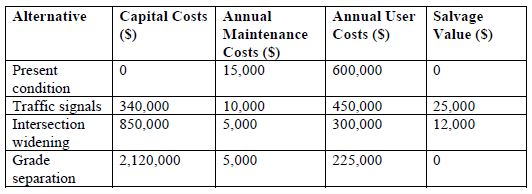Three designs have been proposed to improve traffic flow at a major intersection in a heavily traveled suburban area. The first alternative involves improved traffic signaling. The second alternative includes traffic-signal improvements and intersection widening for exclusive left turns. The third alternative includes extensive reconstruction, including a grade separation structure. The construction costs, as well as annual maintenance and user costs, are listed in the following table for each alternative. Determine which alternative is preferred based on economic criteria if the analysis period is 20 years and the annual interest rate is 15%. Show that the result is the same using the present worth, equivalent annual cost, benefit– cost ratio, and rate-of-return methods.

What will be an ideal response?
Calculate the present worth for each of the alternatives.
PWpresent conditions = 0 + 15000(P/A, 15%, 20) + 600000(P/A, 15%,20)
PWpresent conditions = 0 + 15000(6.259) + 600000(6.259)
PWpresent conditions = $3,849,285
PWtraffic signals = 340000 + 10000(P/A, 15%, 20) + 450000(P/A, 15%, 20) –
25,000(P/F, 15%, 20)
PWtraffic signals = 340000 + 10000(6.259) + 450000(6.259) – 25000(0.0611)
PWtraffic signals = $3,217,613
PWint. widening = 850000 + 5000(P/A, 15%, 20) + 300000(P/A, 15%, 20) –
12000(P/F, 15%, 20)
PWint. widening = 850000 + 5000(6.259) + 300000(6.259) – 12,000(0.0611)
PWint. widening = $2,758,262
PWgrade separation = 2120000 + 5000(P/A, 15%, 20) + 225000(P/A, 15%, 20)
PWgrade separation = 2120000 + 5000(6.259) + 225000(6.259)
PWgrade separation = $3,559,570
Based on the present worth analysis, Alternative III (Intersection widening) is
preferred due to it having the lowest net present worth of costs among all
alternatives.
Calculate the equivalent uniform annual cost (EUAC) for each alternative.
EUACpresent conditions = 0 + 15000 + 600000
EUACpresent conditions = $615,000
EUACtraffic signals = 340000(A/P, 15%, 20) + 10000 + 450000 –
25000(A/F, 15%, 20)
EUACtraffic signals = 340000(0.1598) + 10000 + 450000 - 25000(0.0098)
EUACtraffic signals = $514,087
EUACint. widening = 850000(A/P, 15%, 20) + 5000 + 300000 –
12000(A/F, 15%, 20)
EUACint. widening = 850000(0.1598) + 5000 + 300000 – 12,000(0.0098)
EUACint. widening = $440,712
EUACgrade separation = 2120000(P/A, 15%, 20) + 5000 + 225000
EUACgrade separation = 2120000(0.1598) + 5000 + 225000
EUACgrade separation = $568,776
Based on the EUAC analysis, Alternative III (Intersection widening) is preferred.
This is because it has the lowest equivalent uniform annual cost among the
alternatives.
Calculate the benefit-cost ratio for each alternative.
First, compare the traffic signal alternative to the present condition alternative.
BCRII/I = [3,849,285 – (10000 + 450000)(6.259)] /
[340000 – (25000)(0.0611) – 0]
BCRII/I = 2.866
Since BCR is greater than 1.00, the traffic signal alternative is preferred to present
conditions.
Next, compare the intersection widening to the traffic signal alternative.
BCRIII/II = [(10000 + 450000)(6.259) – (5000 + 300000)(6.259)] /
[850000 – (12000)(0.0611) – (340000 – 25000 × 0.0611)]
BCRIII/II = 1.899
Since BCR is greater than 1, the intersection widening is preferred to the traffic
signal alternative.
Next, compare the grade separation alternative to the traffic signal alternative.
BCRIV/III = [(5000 + 300000)(6.259) – (5000 + 225000)(6.259)] /
[2120000 – (850000 – 12000 × 0.0611)]
BCRIV/II = 0.369
Since BCR is less than 1, the grade separation alternative is not preferred to the
intersection widening alternative.
From the benefit cost ratio analysis, the Intersection widening alternative is
preferred.
Calculate the rate of return for each alternative.
First, compare the traffic signal alternative to the present condition alternative.
NPWII/I = 0 = –[(340000 – 25000 × 0.0611) – 0] + [(15000 + 600000) –
(450000 + 10000)](P/A, i, 20)
NPWII/I = 0 = –338473 + 155000(P/A, i, 20)
(P/A, i, 20) = 338473 / 155000
(P/A, i, 20) = 2.184
i = 45.8% (by interpolation or by trial and error)
Since the rate of return is greater than 15%, the traffic signal alternative is
preferred to the present conditions alternative.
Next, compare the intersection widening to the traffic signal alternative.
NPWIII/II = 0 = –[(850000 – (12000 × (P/F, i, 20))) – (340000 – (25000 ×
(P/F, i, 20)))] + ((450000 + 10000) – (5000 + 300000))(P/A, i, 20)
NPWII/I = 0 = –510000 –13000(P/F, i, 20) + 155000(P/A, i, 20)
i = 30.2% (by trial and error)
Since the rate of return is greater than 15%, the intersection widening alternative
is preferred.
Next, compare the grade separation to the traffic signal alternative.
NPWIV/III = 0 = –[2120000 – (850000 – 12000(P/F, i, 20)] +
[(300000+5000) – (5000 + 225000)](P/A, i, 20)
NPWII/I = 0 = –1270000 – 12000(P/F, i, 20) + 75000(P/A, i, 20)
i = 0.59% (by trial and error)
Since the rate of return is less than 15%, the grade separation alternative is not
preferred.
Therefore, based on the four different economic analyses performed above
Intersection Widening Alternative is the best alternative.
You might also like to view...
If an A/C system is set to "BI-LEVEL" where is the air directed?
A) Dash vents and floor B) Floor and defrost C) Floor only D) Dash vents only
The first step in applying the building code to a project is to ______.
A) determine if the building is provided with an automatic sprinkler system. B) determine the number of exits from the building at the ground floor. C) determine the occupancy classification of the building. D) determine the width of open spaces around the building.
In order to determine the current flowing through an RC series circuit when the total voltage, R and XC are known, you must first calculate the total ____________________.
Fill in the blank(s) with the appropriate word(s).
Perspective drawing.
a. 1:1 b. 1:2 c. 2:1 d. no scale